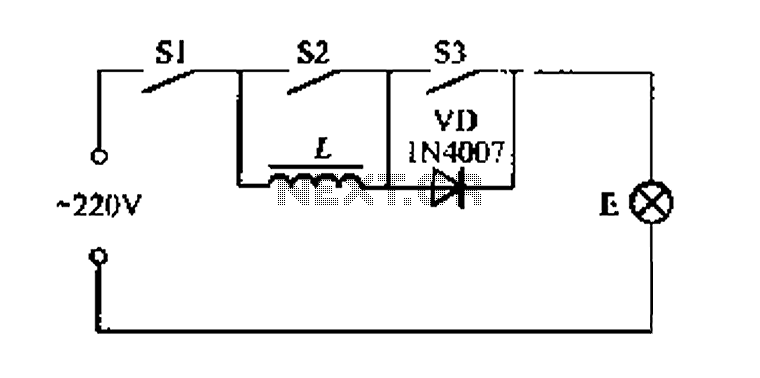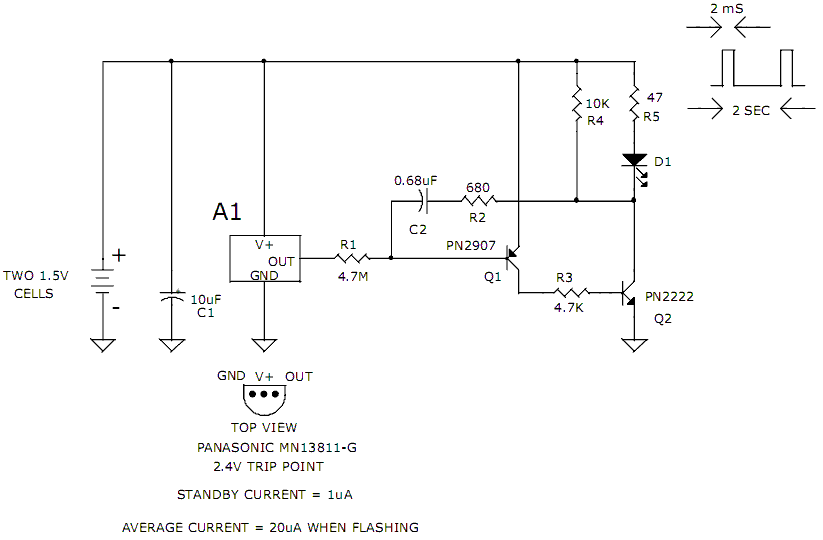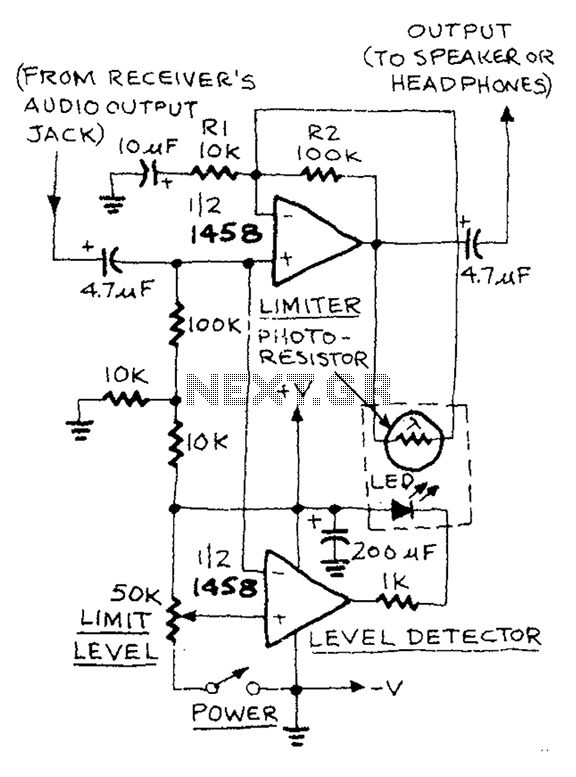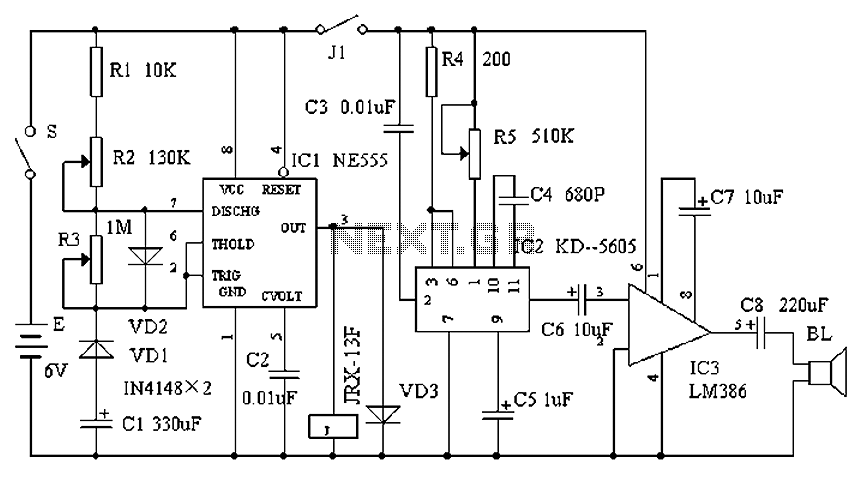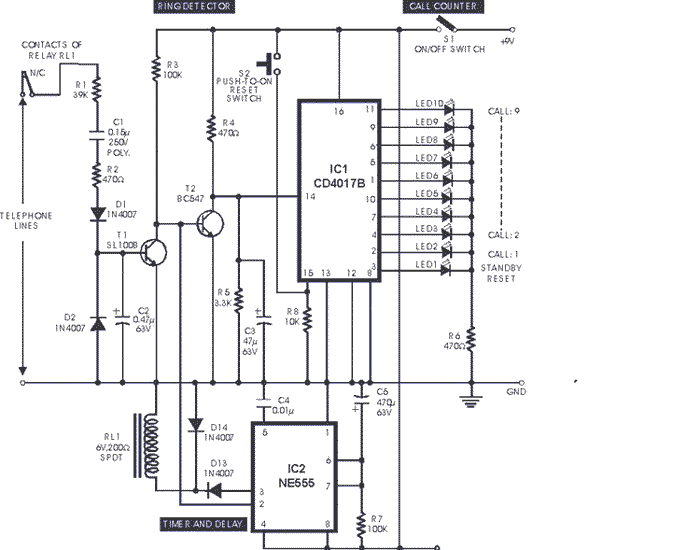
Dual timing circuit thyristor control table
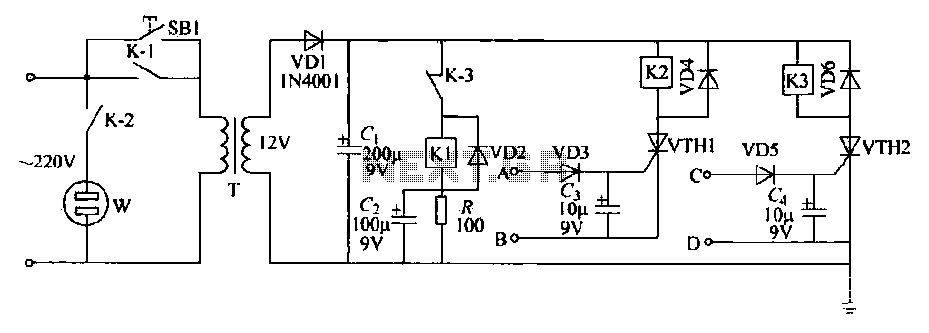
This schematic circuit features two alarm outputs controlled by a timer using thyristors. The system can be turned on or off and will shut down after the power supply is interrupted. It employs a transformer on the primary side for power, ensuring no depletion, safety, energy savings, and high reliability. When the switch SB1 is pressed, power is supplied through transformer T, generating a 6V DC output via the buck rectifier filter CI. This power supply, through a normally closed contact K-3, activates relay Kl, which, with its normally open contact Kl-1, creates a self-locking electric circuit. Once SB1 is released, the circuit remains in a working condition due to self-locking. When the timer reaches the end of the audio signal from inputs A and B, diode VD3 and capacitor C3 trigger the thyristor rectifier filter VIH1, energizing relay K2. The normally open contact K-2 closes, powering the connected appliances. Conversely, when the timer for the audio signal from another alarm branch, inputs C and D, activates through diode VD5, it triggers relay K3 via rectifier G. This releases the normally closed contact K-3, cutting power to Kl, which also disconnects the normally open contacts Kl-1, halting the entire circuit. Resistor R1 serves as a current limiting resistor, C2 acts as a start capacitor for Kl, and diodes VD2, VD4, and VD6 provide protection.
Component parameters include a 12V transformer T with a small output current that exceeds the sum of the operating currents for relays Kl, K2, and K3. Relays K1, K2, and K3 are small single-pole relays rated for 6V. The current through K2 can control the electrical power load. The thyristor should be rated for tens of milliamps. Specific component selection is illustrated in Figure 3-35, which does not require any special specifications.
The dual timer circuit for thyristor control is depicted in Figure 3-35, illustrating how the timing mechanism operates in conjunction with the thyristor control to manage the alarm outputs effectively. The design emphasizes energy efficiency and reliability, making it suitable for various applications where alarm signaling is necessary. Each component is selected to ensure optimal performance, with careful consideration given to the operating parameters and safety features to prevent circuit failure or damage to connected devices.Electronic Table (1) Introduction This schematic circuit having two alarm output by the timer by thyristor controlled. Can any on/off, and shut down after the power supply from the transformer primary (side) power, no Depletion, safety, energy-saving, high reliability. Press the SB1 use, the power supply via T, f) 1, CI buck, rectifier filter obtained 6V DC. In this case power supply through a normally closed contact K-3 makes Kl work, normally open contacts Kl-l closed electric road self-locking. At this point after the release SB1 circuit due to self-locking and in working condition, when the timing for the start of the audio signal from the A, B input ends, the VD3, C3 triggered thyristor rectifier filter VIH1, electrical work so K2, K2 often open contact K-2 is closed.
W socket is energized, the controlled appliances are turned on. Similarly, when the timing off the audio signal of another branch Alarm clocks from C, D enters through VD5, after G rectifier trigger electrical work fH2t K3, K3 normally closed contact K-3 release disconnect, Kl loss of power, so that the normally open contacts Kl Kl release also disconnected, the entire circuit to stop working. Ri was eye resistor, C2 to Kl start capacitor, VD2, VD4, VD6 as protection diodes. (2) Component parameters 12V transformer T with a small output current is greater than Kl, K2, K3 sum of the operating current.
KJ, K2, K3 available 6V small single-pole relay. K2 contact current can be controlled by electrical power. Thyristor tens mA to use. Choice of components shown in Fig. 335, no special to the ball. (3) Dual timer circuit thyristor control table shown in Figure 3-35.
Component parameters include a 12V transformer T with a small output current that exceeds the sum of the operating currents for relays Kl, K2, and K3. Relays K1, K2, and K3 are small single-pole relays rated for 6V. The current through K2 can control the electrical power load. The thyristor should be rated for tens of milliamps. Specific component selection is illustrated in Figure 3-35, which does not require any special specifications.
The dual timer circuit for thyristor control is depicted in Figure 3-35, illustrating how the timing mechanism operates in conjunction with the thyristor control to manage the alarm outputs effectively. The design emphasizes energy efficiency and reliability, making it suitable for various applications where alarm signaling is necessary. Each component is selected to ensure optimal performance, with careful consideration given to the operating parameters and safety features to prevent circuit failure or damage to connected devices.Electronic Table (1) Introduction This schematic circuit having two alarm output by the timer by thyristor controlled. Can any on/off, and shut down after the power supply from the transformer primary (side) power, no Depletion, safety, energy-saving, high reliability. Press the SB1 use, the power supply via T, f) 1, CI buck, rectifier filter obtained 6V DC. In this case power supply through a normally closed contact K-3 makes Kl work, normally open contacts Kl-l closed electric road self-locking. At this point after the release SB1 circuit due to self-locking and in working condition, when the timing for the start of the audio signal from the A, B input ends, the VD3, C3 triggered thyristor rectifier filter VIH1, electrical work so K2, K2 often open contact K-2 is closed.
W socket is energized, the controlled appliances are turned on. Similarly, when the timing off the audio signal of another branch Alarm clocks from C, D enters through VD5, after G rectifier trigger electrical work fH2t K3, K3 normally closed contact K-3 release disconnect, Kl loss of power, so that the normally open contacts Kl Kl release also disconnected, the entire circuit to stop working. Ri was eye resistor, C2 to Kl start capacitor, VD2, VD4, VD6 as protection diodes. (2) Component parameters 12V transformer T with a small output current is greater than Kl, K2, K3 sum of the operating current.
KJ, K2, K3 available 6V small single-pole relay. K2 contact current can be controlled by electrical power. Thyristor tens mA to use. Choice of components shown in Fig. 335, no special to the ball. (3) Dual timer circuit thyristor control table shown in Figure 3-35.
